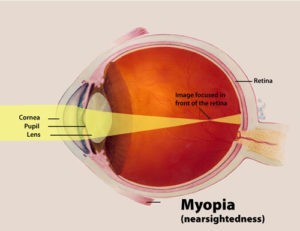Blog
Myopia (Nearsightedness)

What is myopia?
Myopia is another name for nearsightedness. If you have myopia, objects that are far appear less clear to you than those that are closer. You may see well enough to read a book but struggle to read road signs when you are driving, for example. Myopia is very common, affecting some 42 percent of Americans ages 12-54 (up from 25 percent in 1971). It is most common in East Asians and least common among African blacks, and also more common in urban compared with rural children.
How does myopia develop?
Myopia is a problem of refraction: the bending of light as it passes through one object to another. In the eye, light passes through the cornea and the lens and then focuses on the retina—the part of the back of the eye which receives light and processes it, sending messages to the optic nerve in the brain. Your brain translates these messages into the images you see with your eyes. If you have myopia, the eyeball is too long and it focuses light in front of the retina, instead of on it—resulting in blurry vision.
Myopia may also result when the cornea is too curved for the length of the eyeball or the lens of the eye is too thick.
What causes myopia?
Sometimes we don’t know. But in some people, there is a genetic cause. In fact, about two dozen genetic factors have been identified that contribute to myopia, and the more of them you have, the greater your risk of being nearsighted.
There has also been a dramatic increase in myopia that has been attributed to less time spent outdoors and more time doing “near work,” such as reading, writing, and working on a computer. Research has actually shown that children who spent more time outdoors had a reduced chance of developing myopia. It may have to do with more time focusing on distant objects outside, or exposure to natural sunlight. However, once myopia develops, you can’t reverse it by spending more time outdoors.
What are the symptoms of myopia?
If you have myopia, you may experience:
- Difficult seeing distant objects clearly
- Headaches
- Eyestrain
If you have any of these symptoms, contact an eye care professional for an eye examination. A comprehensive dilated eye examination is the best way to accurately assess your vision and determine if you need vision correction.
What is high myopia?
High myopia occurs when the degree of nearsightedness is severe. If you have high myopia, you have an increased risk of a detached retina, cataracts, and glaucoma, any of which can cause vision loss. So see your eyecare professional regularly to monitor your eye health. Pathological myopia (also called degenerative or malignant myopia) is a form of high myopia in which excessive elongation of the eye causes changes in the retina, sclera (outer white part of the eye), choroid (middle layer of the eye, between the retina and sclera), vitreous (gel inside the eyeball), and/or the optic nerve.
Is myopia correctable?
If you learn you are nearsighted, your eye care professional will speak with you about options for improving your vision and what may work best for you. Your choices may include:
- Eyeglasses, the safest and simplest way to correct vision challenges caused by myopia, which can help you see the world more clearly.
- Contact lenses are helpful for people with myopia. As the first surface light hits when it enters your eye, a contact lens can achieve better refraction and focus. Many people find that contact lenses not only give them clearer vision, but a wider field of vision as well—in addition to comfort because they don’t need to wear glasses. However, some people are not comfortable with contact lenses. Talk with your eye care professional to see if they might be right for you.
- Surgery helps some people with myopia by changing the shape of the cornea permanently. Such “refractive surgery” alters the eye’s shape using lasers so that light passing through is more finely focused, enhancing the clarity of your vision. Speak with your eye care professional about the different types of surgery to learn if one of them might be an option for you. Sometimes people who have refractive surgery for nearsightedness find they will need reading glasses to read.
- Phakic intraocular lenses (PIOL) may help people who are very nearsighted but are not candidates for laser eye surgery due to thin corneas. These lenses are surgically placed inside the eye to better focus light on the retina.